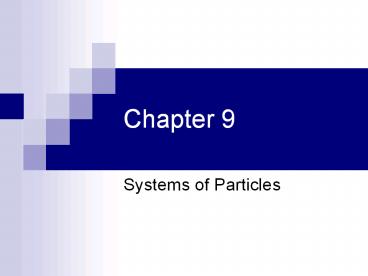Systems of Particles - PowerPoint PPT Presentation
1 / 32
Title: Systems of Particles
1
Chapter 9
- Systems of Particles
2
Center of Mass
Real objects are not point particles
How do I define the position of the cow? What is
h for U mgh?
Take average position of mass Center of mass
Treat extended objects as point particles at CM
(Easy for spherical objects)
3
Center of Mass (Discrete)
To find the center of mass for a bunch of point
masses m1, m2, m3, at r1, r2, r3,
rCM
4
Center of Mass (Continuous)
For an extended object, break it into point
masses (mass dm)
Note This equation assumes that density is
constant
5
Center of Mass (Demo)
3
4
To balance, rcm 0
m1 0.5 kg
m2 ???
6
Center of Mass (Bigger Demo)
1
14
Again, to balance rcm 0
m2 ???
m1 14.7 kg
As before
Why didnt it work this time?!
7
Center of Mass (Bigger Demo)
1
14
We forgot about the bar! mbar0.745 kg
m1 14.7 kg
m2 ???
CM in center of bar
0.5
7
8
Center of Mass (Bigger Demo)
1
14
m1 14.7 kg
m2 ???
9
Center of Mass Example
m1 at position (1,1) meter m2 at position (2,0)
meter
m1 3 kg
Mtotal 8 kg
m2 5 kg
10
Center of Mass for 2D objects
Often dont need to do integral Use symmetry
m1 3 kg
Can also add symmetric objects together
11
Another Way to Determine CM
12
Why Do We Want Center of Mass?
Can treat extended objects or groups of objects
as points
aCM Ftot /Mtot
Gravity pulls on CM h hCM for Ugrav
13
Mystery Hill
Gravity pulls down on the CM of the system
14
Example (Problem 9.9)
A cylindrical can with mass M, height H, and
uniform density is initially filled with soda/pop
of mass m. We then punch a hole in the top and
bottom so that the liquid can drain out. Find
- The center of mass of the can when full
- The center of mass of the can when empty
- What happens to the height of the CM while
draining? - Find the height of the soda/pop when the CM
reaches its lowest point
This one is pretty tough!
15
Momentum
New fundamental quantity (like force,energy,..)
For point particle p mv
For group of particles ptotalm1v1m2v2...
For extended object pCM mvCM
Relation to Force Ftot ma
m dv/dt
dmv/dt
16
Conservation of Momentum
If Ftot 0, then momentum is constant
For an isolated system (no external forces)
True also for groups of particles
If Fexternal 0, then pCM constant
Even if there are internal forces
17
Momentum of a Noisy Cricket
Will Smith 200 lbs 91 kg
Thrown back 3m in 1s ? 3 m/s
18
Momentum of a Noisy Cricket
So how much energy is this?
But light is massless
Looking ahead to Phys 214
Recall A car at 60 mph has 105 J!
19
The Celebrated Jumping Frog of Calaveras County
3 m
A 2 kg frog sits on the end of a motionless,
floating 50 kg log (3 meters long).
She jumps to the other end.
How far does the log move due to the jump?
20
Celebrated Jumping Frog (cont.)
Initial
x
Final
Consider frog and log together as a system of
objects
No external forces ? momentum of system doesnt
change?
pinitial pfinal 0
Center of mass of system does not move
21
Celebrated Jumping Frog (cont.)
xCM 1.53 m
x
x 0
x 1.5m
x 3m
CM does not move, log moves to keep it in same
place!
1.53 m
From geometry, we see that
initial
1m
1.53 m
x
final
22
Gun and Bullet
Both are at rest when fired, no net external force
Total Momentum pinitial pfinal 0
What does this say about the motion after the
gun is fired?
23
Gun and Bullet (continued)
mB ltlt mG so vG ltlt vB The gun is heavier so
it moves slower!
24
Gun and Bullet (Question 1)
Does the Center of Mass of the system move?
No, because pinitial pfinal 0 for the system!
25
Gun and Bullet (Question 2)
If the momenta are the same, why do you want to
hold the gun rather than catch the bullet?
Consider the kinetic energy
K ½mv2 p2/(2m)
pG pB and mB ltlt mG ? KG ltlt KB
26
Spaceship Example
A spaceship in outer space, free from any
interactions with other objects, has mship34,000
kg and vship,i1,000 m/s i. The ship launches a
satellite msat1,000 kg which moves with
vsat,f(1,500m/s)i (400 m/s)j. What is the
velocity of the spaceship after the satellite
launch?
27
Spaceship (continued)
No external forces, so momentum is conserved
Solve for vship,f
28
Spaceship (question)
Is Kinetic Energy conserved?
Kinitial Kship ½mtotal(vinitial)2
½(3.5 x 104 kg)(1000 m/s)2 1.75 x 1010 J
Kfinal Kship Ksatellite ½mshipvship2
½msatvsat2
½(3.4 x 104 kg)(985 m/s)2 (11.8 m/s)2
½(1000 kg)(1500 m/s)2 (400 m/s)2
1.77 x 1010 J
NO! Extra energy added when satellite ejected.
29
Rockets
A gun shooting a bullet is a discrete process
We can generalize this to continuous processes
Rockets operate by shooting outa continuous
stream of gas
Note Rocket propulsion was originally thought
to be impossible
Nothing to push against!!
30
Rockets
31
Rockets
?m 0
Note dm -dM
Dividing both sides by dt
Let dM/dt -R, where R is the rate of fuel
consumption
32
Rockets
To find the velocity of the rocket we must
integrate
Note Velocity is a function of mass loss, not
time































